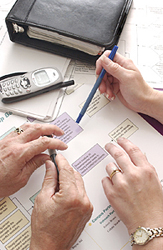Working Together with Us
Outreach Partnerships is a multidisciplinary unit under the direction of the Assistant Provost for University Outreach & Engagement at Michigan State University. It establishes agreements and partnerships with external agencies and community organizations to facilitate the local development of solutions.
Based on initial discussions with our partners and by mutual agreement, we discuss how they might want to consider applying the Outcome-Asset Impact Model (O-AIM), as a structured way to approach positive change, as well as a way of thinking about the world and social issues from an outcome/asset perspective.
The intended result of the partnership is a locally driven, research-informed process that increases local capacity to achieve positive change, designed specifically for the situation. At every stage of our partnership, we combine scholarship with local expertise to help develop a vision for a healthy, capable community that is both achievable and measurable.
Types of Agreements

Outreach Partnerships engage in three different types of agreements that vary in duration and involvement, depending on the needs of the community or agency requesting our consultation.
Accordingly, fees for these services also range in price. Agreements begin with a free initial consultation. Workshops or presentations are generally charged at a daily rate of $750. Full partnerships vary the most in fees based on the estimated time needed to accomplish the goals of the partnership. Past partnerships have ranged in cost from $5,000 to $14,000 per year. Partnerships’ goal is to make a difference, not to make money; fees charged simply cover expenses incurred.
- The first type of agreement is most limited in terms of its scope and only includes a single training session or workshop. This type of agreement focuses on the transmission of information.
- The second type of agreement is more involved and includes a series of sessions where participants have the opportunity to apply the information that they gain to a specific area.
Both types of agreements can include workshops related to areas such as identifying community assets, improving internal organizational communication, capacity-building, improving interagency collaboration, or training on developing strategic, intervention, and evaluation plans.
- The third type of agreement involves a full partnership and helps people, groups, or agencies incorporate the O-AIM.
This type of partnership allows people and organizations to experience transformational change that goes beyond only transmitting knowledge. The sessions are structured to increase the capacity of participants to examine how they perceive social issues, to explore their belief systems, and to consider how to expand the capacity of those affected by their work. Depending on the scope of their interests, they may also examine the leadership that human service agencies can provide to mobilize all aspects of their community in a unified effort to create a capable community.
The section below describes the general steps involved in establishing a full partnership.
The Partnership
The approach for the change process varies significantly based on the particular interests and circumstances of the people attempting to promote positive local change and is unique to each partnership. However, the steps commonly occur as follows:
- An informal contact is made to discuss the circumstances of the local person or persons interested in change. Based on that discussion, we provide an overview of the possible fit with the O-AIM and the basic options that are available.
- We often then make an on-site presentation of the O-AIM to a local board, administrators, or citizens at no cost to the requestor. A discussion follows to see if the model matches the local interests, and if our interest in expanding outreach scholarship can be accommodated in the effort. If both parties' interests can be met, general agreement on a plan and budget estimate is negotiated.
- A formal written agreement is then developed, showing what will be done, when it will be done (if known), and at what cost. Any MSU in-kind contributions are noted, as are the costs to the requestor as work is completed.
- The local group assembles a small work group, with a lead local contact. We provide training in the O-AIM and an overview of the proposed steps involved in its implementation to individuals selected by the lead local facilitator. Based on the agreement, an expanded group of local participants, assembled by the small work group, is trained in the approach and assisted in developing plans to adapt and implement the model to the local circumstances.
- Over the course of the long-term relationship, as others are drawn in to work on the application of the model and local capacity increases, our on-site (billed) consultations decrease. We then increase our phone and e-mail consultations (normally without cost to the local participants).
NEXT PAGE> Go to the next section for information on how to contact us


